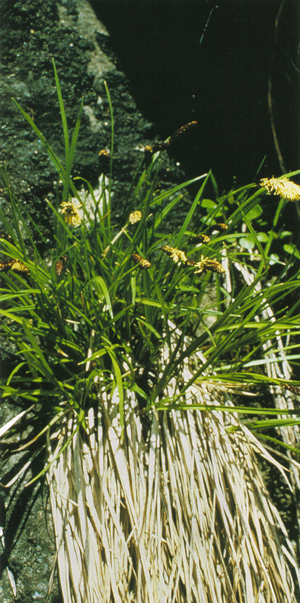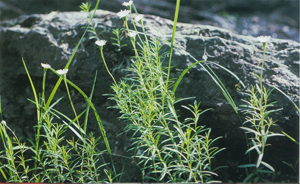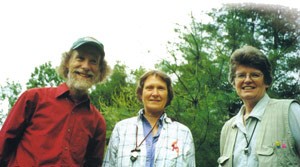On a spectacular summer day in July, three of us – all botanists – gathered our gear together at a remote trailhead in Vermont’s Northeast Kingdom. Dorothy Allard, Annie Reed, and I are all members of the Vermont Scientific Advisory Group on Flora, which advises the state Endangered Species Committee on plant issues. But that day’s task was very different.
We were trying to retrace the steps of Arthur Stanley Pease, an avid amateur botanist who had collected a number of rare plants in this isolated area in 1929. Pease had donated his entire plant collection to the New England Botanical Club (NEBC) and the Gray Herbarium at Harvard in 1912. Each summer thereafter, he would add specimens he collected, but his collection from this site in Vermont remained unnoticed for many years until it was rediscovered by the New England Wildflower Society in its examination of the collections of all the major New England herbaria.
Although many interesting records surfaced during the Wildflower Society’s examination, the Pease collections were the most notable. Three specimens in particular caught our attention: bentgrass, scirpus-like sedge, and Blake’s milk-vetch. All three are rare in Vermont, occurring at fewer than 10 locations statewide. The bentgrass, the rarest of the three and known from only three locations in Vermont, is also legally protected as an endangered species.
So we set off to see if we could locate the species Pease had collected. But even before we got started, there was a discrepancy that puzzled us. A quick scan of topographic maps and aerial photos clearly indicated there was indeed an open cliff face on the mountain mentioned on Pease’s collection labels. This mountain was depicted on the bedrock geology map as granitic and surrounded by granitic rock. Our three target species, however, are all calciphiles – they require calcium and thus are all restricted to areas of calcareous bedrock. How could they be growing on granite? Adding to the quandary, the mountain mentioned in Pease’s notes is not the only one in Vermont with this name. But even though we weren’t sure we were headed to the right mountain, we decided that the evidence was too intriguing to pass up, and off we went, expecting nothing more than a pleasant hike to a perhaps impressive, but botanically dull, acidic cliff.

Carex scirpoidea, the rare scirpus-like sedge
We soon left the marked trail to bushwhack along the side of the sometimes-steep, south-facing slope. Using an altimeter and compass, we attempted to follow the contour around the mountain to our goal – the remote cliff face mentioned in Pease’s collection notes.
There were some tantalizing clues that we were indeed on the right track. After leaving the trail, we noted widely scattered but regular clumps of Braun’s holly fern. There were also occasional rich pockets of stinging nettle, maidenhair fern, silvery glade fern, blue cohosh, wild millet, and plantain-leaved sedge. These species are all good indicators of soils enriched by calcareous bedrock; none of them typically occur with any frequency on granite. But by far the most exciting clue was a species that we had seen from afar. Before heading off on the trail, we had stopped for a look at the cliffs, and through binoculars we noted a fringe of what appeared to be northern white-cedar along the edges of the cliff. Knowing that this calcium-loving tree was up there provided ample incentive to continue our 2-hour bushwhack over blowdowns and across the steep slope.
Following the lengthy scramble, our progress was slowed considerably by having to climb over and around refrigerator-size boulders. But coming upon this steep talus slope gave us hope that we were getting close, because the boulder fields are generally situated beneath cliffs. We knew for certain that we had reached our destination when northern white-cedar began to appear – first as scattered individuals and then becoming more dense as the wooded talus abruptly opened up onto an approximately two-acre slab of rock tilted from about 45 degrees to nearly vertical. The cliffs, over 1,200 feet long and perhaps half as wide, were mostly unvegetated except for the scattered flat benches that harbored small cedar thickets and the numerous cracks in the rock that provided moisture and a rooting substrate for various herbaceous species. Many of these plants, we noted, are restricted to areas with groundwater seepage, generally limy or neutral, but most certainly not acidic.
While Annie and Dorothy headed for the bottom, I found an area mid-slope that was just flat enough to scramble out onto a narrow bench. I noticed a small, flowering member of the aster family farther out on the slope. Unable to safely reach it, I viewed it through my binoculars. It was hyssop-leaved fleabane, a rare plant in Vermont that is restricted to calcareous outcrops and cliffs. It was only then that I looked down and saw, growing right next to my foot, both male and female plants of the dioecious, scirpus-like sedge that Pease had collected in 1929. I knew then that we had rediscovered Pease’s station. I stood on the narrow bench taking in the 180-degree vista and realized that I was probably the first botanist to set foot on these cliffs since Pease did more than seven decades ago.
In the next few hours, we were able to relocate the state-endangered bentgrass, but found no evidence of the milk-vetch. We also discovered some additional rare and uncommon species that were apparently not collected by Pease or at least not housed with his other collections at Harvard. Among them were swamp thistle, an uncommon native whose noxious cousin is the ubiquitous Canada thistle, and green alder, an uncommon relation of the common swamp alder that grows only on calcareous cliffs and river shores. Our most spectacular find was confirmed only later, however, when we were able to verify its identity in a technical plant key. We had located a new station of Buxbaum’s sedge, only the second known population in the state. The total for the day was six rare or uncommon species. The only one collected by Pease that managed to elude us was the Blake’s milk-vetch.

Erigeron hyssopifolius, or hyssop-leaved fleabane
Our story could end here, but there is still one puzzling question: the explanation for the apparent discrepancy with the bedrock geology map. To attempt to solve this I made a visit to the Vermont State Geologist, Larry Becker, who offered two possible explanations, both based upon the presence of the calcareous Waits River formation occurring nearby.
The answer needed to wait until I was able to revisit the site with Scott Bailey, a geo-ecologist at the Hubbard Brook Experimental Forest in Woodstock, New Hampshire. This time we approached the cliffs from above. After bushwhacking down from the summit through spruce-fir forest, we abruptly crossed into a narrow band of enriched hardwood forest. This community, dominated by sugar maple and containing numerous rich herbs, typically occurs on fertile soils, not on granite at elevations of 2,800 feet in the Northeast Kingdom of Vermont. As we reached the top of the cliffs, we observed bedrock that was very different from that of the cliff. Bailey quickly confirmed that Becker had been right – it was the Waits River formation. The pH of the cold water seeping from the rock was 7.7, an indication of very limy conditions, and further confirmation of the calcium-rich rock.
The plants had simply “found” within the granite an inclusion of calcareous rock that extended in a band about 200 feet wide for the length of the cliffs. This formation accounts for the rich, forested band above the cliffs and the numerous rare, calcium-loving plants that extend onto the granite cliffs, sustained by calcium-rich seepage.
Although this solves our mystery, I have one other question that perhaps may never be answered: how did Arthur Stanley Pease come upon this site, which remains remote today, but in 1929 must have been in the middle of wilderness?


